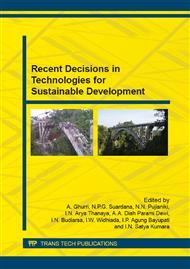p.36
p.41
p.47
p.53
p.59
p.66
p.74
p.80
p.87
Experimental and Theoretical Investigation of Bolted Bamboo Joints without Void Filled Material
Abstract:
An experimental and theoretical are presented to calculate the load capacity of shear single connection (SSC) and shear double connection (SDC) without void filled material. The model presents an extension of the Johansen theory for bamboo connection type, also known as the European Yield Model (EYM). The bamboo of Gigantchloa atroviolacea of the most popular as non-wood has been used as a construction material in some region of Indonesia. The uniqueness bamboo is bamboo non-homogen material, sectional shape non-prismatic, the straighthness stems not same, on the culms guiler node and a cross-section in hollow. The diameter of Gigantochloa atroviolacea bamboo used in this study is ranged from 70 to 90 mm. The diameter of bolt is 12.7 mm. The connection strength can be determined with theoretical and eksperimental. Application theory of the European Yield Model could be developed into theory of connection laterally strength of bamboo without void filler material. Factors that affected of connection laterally strength is bamboo thickness, bolt diameter and spesific gravity. The equation four of connection strength base on European Yield model can calculated of according to yield model of accurred. The connection strength is specified from the value smallest of the equation four of connection yield models.
Info:
Periodical:
Pages:
59-65
Citation:
Online since:
July 2015
Authors:
Keywords:
Price:
Сopyright:
© 2015 Trans Tech Publications Ltd. All Rights Reserved
Share:
Citation:


